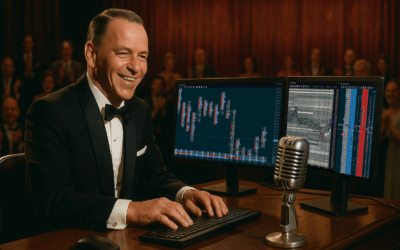The Lose Drill
In my last blog, I discussed how to improve your win-rate and PnL in 2 simple steps. The response has been fantastic – it’s clear you guys want practical techniques you can apply right away, not more theory.
This got me thinking about the massive gap that exists between professional trader development and retail trader development. After 12+ years of working with both prop shops and individual traders, I’ve seen exactly what separates those who make it from those who don’t. A lot of it comes down to how traders are trained.
Professional Traders Don’t Do What You Think
Here’s something that might surprise you. When you join a prop trading firm, they don’t actually hand you some secret “winning strategy” on your first day. No magic indicators. No perfect setup. No secret sauce.
What do they do instead? They put you through a structured program, much of it focused on trading drills that give you specific trading skills – turning them from theory into reflexes.
These aren’t your typical YouTube tutorial exercises. These drills teach new traders more about market dynamics and trade management than typical trading education provides in a year. It’s a game-changer compared to the traditional retail approach of learning ‘market theory’ instead of developing actual ‘trading skill’.
Enough Talk – Let’s Get To The Drill
This is the first in a series of professional-grade trading drills we’ll be sharing. Today’s exercise might be the most counter-intuitive one you’ve ever tried.
Trading Exercise #1 – The Lose Drill – Lose On Purpose
For a detailed walkthrough of how to implement this exercise effectively, watch our video:
For just one or two trading sessions, your goal is to LOSE as many ticks as possible based on short-term order flow and price swings.
Now, there’s a catch – you can’t just blindly cross the spread and donate money to the market. You need to actively try to lose by making what you believe are poor trading decisions based on order flow reading.
This exercise will challenge your assumptions about trading and shine a light on your decision-making process in ways traditional practice never could.
Detailed Drill Instructions
This drill is suitable for all traders, regardless of your trading style. The focus is on the early part of trades, so you’ll be looking to hold positions for minutes, not hours. And trust me – this isn’t as easy as it sounds.
To get the full benefit, you should commit to multiple sessions – ideally 5-10 sessions of about an hour each. Here’s how to progress through the drill:
- Start simple: Begin by just trying to lose with a “small but not too small stop/target” – something that’s small enough to be a scalp, but large enough not to get taken out in seconds. For reference, something like a 10-tick stop and 10-tick target on NQ futures works well.
- Develop your approach: As you get comfortable, switch to entering when the flow is against you – or when you THINK it is. By this point, you should be developing a better sense of what “against you” actually looks like.
- Use equal risk-reward initially: Start with a 1:1 risk-reward ratio (for example, 10-tick target, 10-tick stop). Spend a few sessions with these co-equal stops and targets while trying to lose.
- Experiment with targets: Next, modify your target side only (keep stop the same, extend target) and see what happens.
- Experiment with stops: Then try modifying your stop side (keep target the same, extend stop).
I’m deliberately not telling you HOW to modify your stops and targets – that’s something you need to experience for yourself. The insights come from your own discoveries during this counterintuitive process.
Remember, the goal isn’t just to lose money – it’s to gain deeper insights into market behavior and your own decision-making process by approaching trading from this reversed perspective.
What This Drill Teaches You
This unusual exercise delivers benefits far beyond what you might initially expect:
- Exposes Risk Management Blind Spots: You’ll quickly discover where your stop placement and position sizing strategies are weakest when you’re actively trying to exploit them.
- Builds Mental Toughness: Taking losses on purpose desensitizes you to the fear that often paralyzes traders in real situations. When you’ve intentionally experienced losses, real ones become less emotionally charged.
- Strengthens Trading Discipline: By deliberately making “poor” decisions, you’ll develop a clearer understanding of why discipline matters and how easily emotions can derail your trading plan.
- Highlights Overtrading Patterns: Most traders don’t realize when they’re overtrading until it’s too late. This drill quickly reveals those impulses to chase trades or revenge trade after losses.
- Deepens Market Understanding: Trying to lose often reveals surprising market behaviors that don’t align with your expectations, giving you deeper insight into how price actually moves.
- Sharpens Decision-Making: Approaching the market from this reverse perspective forces you to think critically about each trade, improving your analytical skills.
- Reduces Trading Ego: Nothing humbles a trader faster than intentionally losing. This drill helps shift your focus from being “right” to following good process.
- Normalizes Setbacks: By deliberately experiencing losses, you’ll develop healthier reactions to the inevitable downturns that every trader faces.
How To Implement This Drill
To get the most out of this exercise:
- Use a SIM account (obviously)
- Trade a liquid market you’re familiar with
- Make your decisions based on order flow only
- Keep detailed notes on your reasoning for each trade
- Focus on trying to lose consistently
This is just the first of several professional trading drills we’ll be sharing. In the coming weeks, I’ll introduce more exercises that will help you develop and refine your trading edge using the skills you’re building now.
Stay tuned – the next drill might be even more surprising than this one.
Special thanks to Graham at PriceSquawk for allowing us to share these proven prop trading exercises with our community.
Want to implement these drills properly? You’ll need the right tools. The Jigsaw daytradr platform gives you everything required to execute these professional exercises effectively. Check it out here.
BONUS: Take a look into the decision making process of professional traders with this video training series that helps you make smarter trading decisions.




0 Comments